|
|
|
|
|
|
|
Achi-Kochi Japan
Showing many places to visit and foods to eat in Japan
|
|
|
|
|
|
|
|
|
|
|
|
|
Japan
> Chugoku region
> Iwami Ginzan
|
|
|
|
|
|
|
Iwami Ginzan
Oda, Shimane, Chugoku ( Achi-Kochi Japan )
|
|
|
|
|
|
|
|
|
|
|
|
|
( "Achi-Kochi" in Japanese means "Here and there" in English. )
Iwami Ginzan
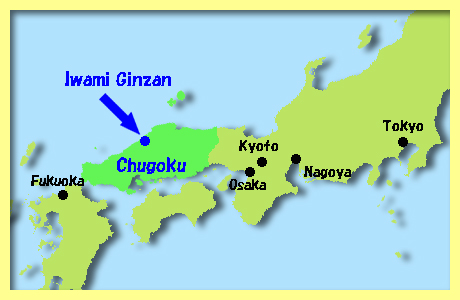
Iwami Ginzan ( above ) is an underground silver mine, located in Oda City, Shimane Prefecture. Though it is said that a silver mine was discovered in A.D.1309 in the area, the underground silver mine had been developed since A.D.1526.
In the early 17th century, Iwami Ginzan silver mine produced one third of the world's silver production. However, the output decreased in the 18th century and the silver production was small in the 19th century. It was in A.D.1923 that the mine was closed.
In A.D.2007, "Iwami Ginzan Silver Mine and its Cultural Landscape" was listed as one of UNESCO World Heritage Sites.
|
|
Entrance to Ryugenji Mabu ( Ryugenji Mine Shaft )
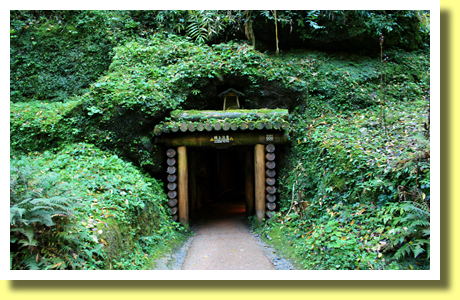
Approximately 600 mine shafts and pits of Iwami Ginzan are included in the UNESCO World Heritage Site. Ryugenji Mabu, one of the mine shafts, is open to the pabulic. Visitors could walk into Ryugenji Mabu through the entrance ( above ).
|
|
Inside Ryugenji Mabu ( Ryugenji Mine Shaft )
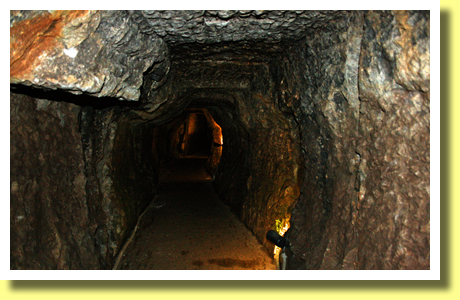
The length of Ryugenji Mabu is 600 meters. Visitors could walk through 273 meters of the mine shaft. Inside the mine shaft ( above ), visitors could see the traces how workers chiseled 300 years ago. The mine shaft had been developed since A.D.1715.
|
|
Adits of Ryugenji Mabu ( Mine Shaft )

There in Ryugenji Mabu are dozens of Adits dug to follow the mineral veins. The adits are too small to walk in. It must have been hard work to dig in the adits 300 years ago.
|
|
Ruins of Yamabuki-jo Castle

There on the top of Yogai-san mountain ( altitude 414 meters - above ) are ruins of Yamabuki-jo Castle, which was built to defend Iwami Ginzan. In the 16th century when Iwami Ginzan was developed, so many warlords were fighting each other ( Sengoku Jidai - Age of Warring States ==> A History of Japan vol.2 Samurai Age ). Silver mine would help warlords fund their war expenses.
Some warlords had contested the silver mines and the castle in the 16th century. However, Ieyasu Tokugawa secured them after his decisive victory in the Battle of Sekigahara in A.D.1600. He established Tokugawa Shogunate in A.D.1603 in Edo ( Tokyo now ). The shogunate had controled Iwami Ginzan for a few centuries.
|
|
Ruins of Shimogawara Refinery

There were cupellation refineries such as Shimogawara Refinery whose ruins ( above ) remain near silver mines. In such refineries, silver had been separated from the ore. Shimogawara Refinery operated in the 17th century.
|
|
Omori Town

To the north of silver mines, there is Omori Town where lived those related to silver production. Also there remain their residences in the town as well as old shrines and temples. A historical atomosphere is preserved in Omori Town ( above ) as was a few centuries ago.
|
|
Kumagai Residence

The Kumagai Family were rich merchants involved with the management of the silver mines in the 17th century, whose residence ( above ) remains in Omori Town and is open to the public.
After many buildings were burnt down in the fire in A.D.1800, the Kumagai Residence was rebuilt. The residence, together with five storehouses, is one of the designated National Important Cultural Properties of Japan.
|
|
Iwami Ginzan Museum

There is Iwami Ginzan Museum ( Iwami Silvermine Museum ) in Omori Town. The museum is located on the site of the office of the magistrate whom Tokugawa Shogunate sent to control the silver mines. On the site remain some buildings such as the gate ( above ) which was rebuilt in A.D.1815. The museum exhibits various materials concerned with Iwami Ginzan.
|
|
Kawashima Residence
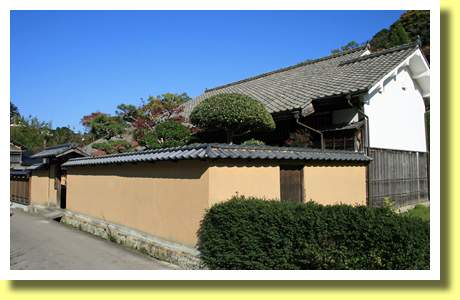
In Omori Twon, there remain samurai residences such as Kawashima Residence ( above ). The Kawashima was a local samurai family who worked under the magistrate sent by Tokugawa Shogunate.
|
|
Kigami Jinja ( shrine )

There is Kigami Jinja shrine in the north of Omori Town. The shrine moved to its present site in A.D.1577 by Terumoto Mori, one of powerful warlords, who ruled the silver mines at the time. The main hall of the shrine was burnt down in a fire in A.D.1800 and was rebuilt in A.D.1812.
|
|
Roaring Dragon
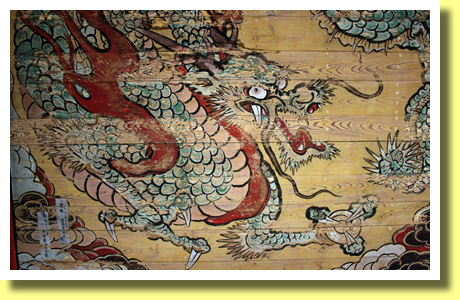
On the ceiling of the main hall of Kigami Jinja shrine, painted is a dragon ( above ). Tourists could stand under the dragon and clap their hands then they hear the echoes like roaring of the dragon. The dragon, painted in A.D.1818, is called "Nakiryu" ( "roaring dragon" ).
|
|
Landscape
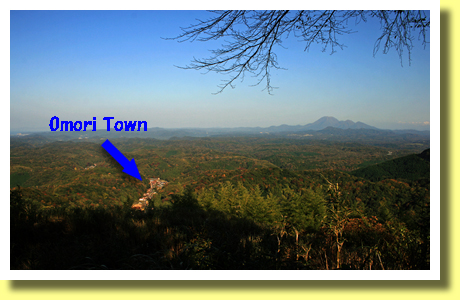
It takes less than an hour to walk from the foot of Yogai-san mountain up to the ruins of Yamabuki-jo Castle, where remain no buildings but ruins of stone walls, gates, dry moats and earthen walls. Tourists could enjoy viewing landscapes from the ruins of the castle overlooking Omori Town ( above ).
In the 16th century, the castle had been attacked repeatedly by warlords - in A.D.1530, 1533, 1537, 1539, 1541, 1558, 1559 and 1562. After Tokugawas Shogunate was establised, the castle was demolished. Sengoku Jidai ( Age of Warring States ) had been over at the time.
|
Copyright (c) 2021 Achi-Kochi Zanmai Co., Ltd.
|